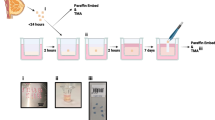Abstract
Cellular heterogeneity of neoplasia is well demonstrated in the Dunning R-3327 rat prostate adenocarcinoma. In this study, we measured the differential expression of invasive and metastatic properties of this prostate model by cloning from a heterogeneous parental cell line. Four cell clones were derived and characterized by morphological studies, E-cadherin expression, and invasive and metastatic potential. Three of the clones (clones 5′A, 5′C, and 5′D) demonstrated a fibroblastic morphology and were anchored to the substrate by loose microvillous processes. The fourth clone (clone 5′B) grew in tight clusters and displayed many closely spaced microvilli, long overlapping cytoplasmic regions with well-defined junctional complexes. The parental line (R3327-5′) demonstrated a combination of both these growth patterns. E-cadherin expression was absent in clones 5′A, 5′C, and 5′D and very prominent in clone 5′B, when compared to the parental line. The absence of E-cadherin expression correlated with increased invasiveness, as measured in an in vitro invasion assay. Subcutaneous injections of clones 5′A, 5′C, and 5′D yielded lung metastases and no primary tumors at the site of inoculation while clone 5′B was tumorigenic and produced fewer lung metastases in vivo. These clones, therefore, provide a potential for studying a variety of molecules involved in prostate cancer invasion and metastasis, especially for the direct testing of the significance of E-cadherin expresssion in prostate cancer progression.
Similar content being viewed by others
References
Bao L, Loda M, Janmey PA et al: Thymosin beta 15: A novel regulator of tumor cell motility upregulated in metastatic prostate cancer. Nature Medicine 2(12): 1322–1328, 1996.
Bussemakers MJG, Moorselaar RJA, Giroldi LA et al: Decreased expression of E-cadherin in the progression of rat prostate cancer. Cancer Research 52:2916–2922, 1992.
Cheng L, Nagabhushan M, Pretlow TP et al: Expression of E- cadherin in primary and metastatic prostate cancer. American Journal of Pathology 148(5): 1375–1380, 1996.
Dong JT, Lamb PV, Rinker-Schaeffer CW et al: KAI1, a metas- tasis suppressor gene for prostate cancer on human chromosome 11p11.2. Science 268:884–886, 1995.
Dunning WF: Prostate cancer in the rat. Monographs of the National Cancer Institute 12:351–369, 1963.
Fidler IJ, Hart IR: Biological diversity in metastatic neoplasms: origins and implications. Science 217:998–1003, 1982.
Frixen U, Behrens J, Sachs M et al: E-cadherin mediated cell- cell adhesion prevents invasiveness of human carcinoma cells. Journal of Cell Biology 111:173–185, 1990.
Frixen UH, and Nagamine Y: Stimulation of urokinase-type plasminogen activator expression by blockage of E-cadherin-dependent cell-cell adhesion. Cancer Research 53:3618–3623, 1993.
Gao AC, Lou W, Dong JT, and Isaacs JT: CD44 is a metastasis suppressor gene for prostate cancer located on human chromosome 11p13. Cancer Research 57:846–849, 1997.
Hendrix MJC, Seftor EA, Seftor REB and Fidler IJ: A simple quantitative assay for studying the invasive potential of high and low metastatic variants. Cancer Letters 38:137–147, 1987.
Isaacs JT, Wake N, Coffey DS, and Sandberg AA: Genetic instability coupled to clonal selection as a mechanism for tumor progression in the Dunning R-3327 rat prostatic adenocarcinoma system. Cancer Research 42:2353–2361, 1982.
Isaacs WB, Bova GS, Morton RA et al: Molecular biology of prostate cancer progression. Cancer Surveys 23:19–32, 1995.
Isaacs JT: The R-3327 System of rat prostatic cancers. Urologic Oncology 2(4): 115–116, 1996.
MacCalman CD, Brodt P, Doublet JD et al: The loss of E-cad- herin mRNA transcripts in rat prostatic tumors is accompanied by increased expression of mRNA transcripts encoding fibronectin and its receptor. Clinical & Experimental Metastasis 12(2): 101- 107, 1994.
Otto T, Birchmier W, Schmidt U et al: Inverse relation of E-cad- herin and autocrine motility factor receptor expression as a prognostic factor in patients with bladder carcinomas. Cancer Research 54(12):3120–3123, 1994.
Rinker-Schaeffer CW, Partin AW et al: Molecular and cellular changes associated with the acquisition of metastatic ability by prostatic cancer cells. Prostate 25:249–265, 1994.
Ross JS, Figge HL, Bui HX et al: E-cadherin expression in prostatic carcinoma biopsies: Correlation with tumor grade, DNA content, pathological stage, and clinical outcome. Modern Pathology 7(8): 835–841, 1994.
Rowley DR, Feuchter FA, and Heidger PM: Aclar plastic substratum: A cell culture method facilitating preparations for electron microscopy and replicate sampling. Tissue Culture Assn. Man. 5:1067–1069, 1979.
Takeichi M: Cadherins: a molecular family important in selective cell-cell adhesion. Annual Review of Biochemistry 59: 237–252, 1990.
Takeichi M: Cadherins in Cancer: implications for invasion and metastasis. Current Opinion in Cell Biology 5:806–811, 1993.
Thompson SA, Johnson MP, Heidger PM and Lubaroff DM: Characterization of the heterogeneity of R-3327 rat prostatic tumors derived from single-cell clones. The Prostate 6:369–387, 1985.
Umbas R, Isaacs WB, Bringuier PP et al: Decreased E-cadherin expression is associated with poor prognosis in patients with prostate cancer. Cancer Research 54(14):3929–3933, 1994.
Author information
Authors and Affiliations
Rights and permissions
About this article
Cite this article
Luo, J., Sharma, N., Seftor, E.A. et al. Heterogeneous expression of invasive and metastatic properties in a prostate tumor model. Pathol. Oncol. Res. 3, 264–271 (1997). https://doi.org/10.1007/BF02904285
Received:
Accepted:
Issue Date:
DOI: https://doi.org/10.1007/BF02904285




